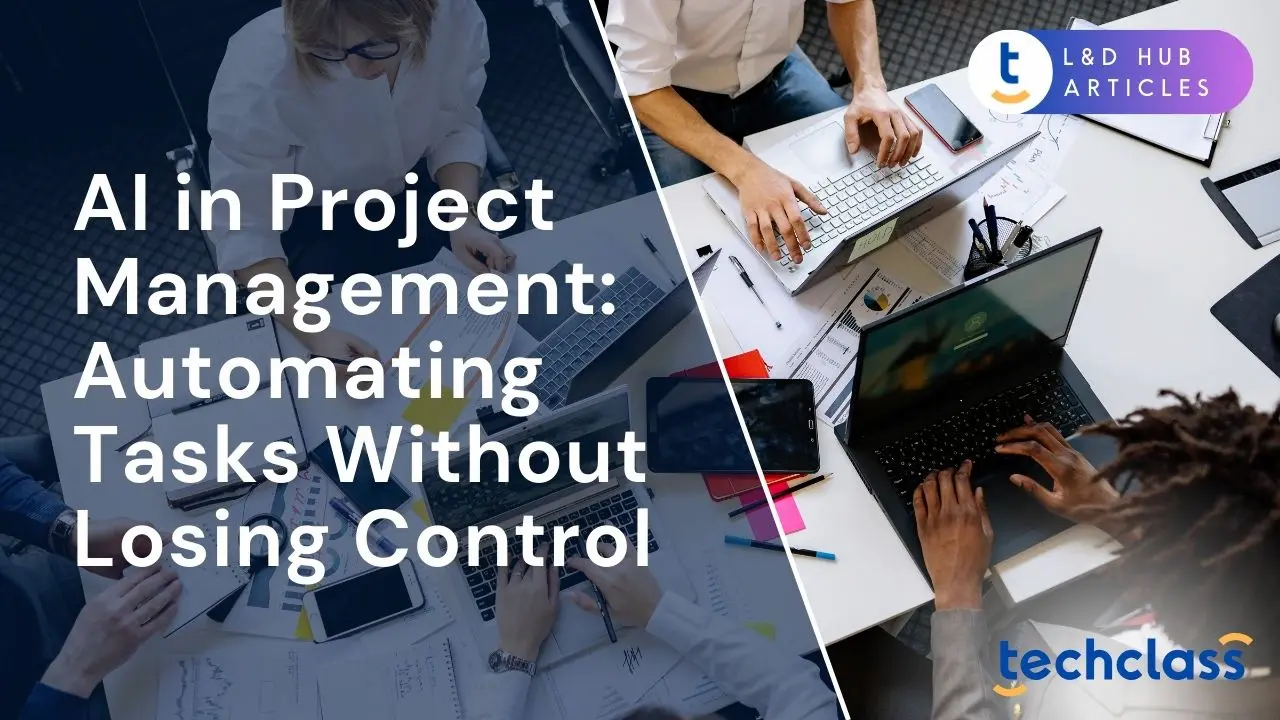
Artificial Intelligence is rapidly becoming a pivotal force in how projects are planned and executed. Project leaders across industries, from tech and construction to finance and healthcare, are exploring AI-driven tools to automate routine project tasks and augment decision-making. In fact, adoption is widespread: one recent study found 93% of organizations are using AI in some business capacity, including project management, although only a small fraction have proper governance in place. This surge in interest is driven by AI’s promise to handle time-consuming administrative work, analyze complex datasets for insights, and even predict project risks, all of which can free human managers to focus on strategic leadership.
However, alongside the enthusiasm lies a note of caution. Busy executives, HR professionals, CISOs, and project managers themselves are asking: How far can we automate without losing control? AI can crunch numbers and churn schedules at superhuman speed, but if left unchecked it might introduce new risks or make opaque decisions. The goal, then, is not to replace the human touch but to leverage AI as a powerful assistant, one that amplifies efficiency while keeping project managers firmly in command. In the sections that follow, we’ll explore the benefits of AI task automation in project management, the potential pitfalls of over-automation, and strategies to harness AI responsibly so that organizations reap the rewards without sacrificing oversight and control.
AI is no longer a futuristic concept for project management; it’s here today, transforming how teams operate. Driven by advances in machine learning and readily available AI services, project management tools are increasingly integrating AI features. Senior business leaders recognize the trend: in a global survey, 82% of executives said AI will have at least some impact on how projects are run over the next five years. This is not surprising, as modern projects generate vast amounts of data (schedules, budgets, risk logs, team communications, etc.) that AI can analyze far faster than any person. By applying AI algorithms to these data, organizations see an opportunity to uncover patterns and efficiencies that were previously hidden.
Crucially, AI excels at automating the low-value, repetitive parts of project management. For example, AI assistants can log and track tasks, update schedules, or send routine reminders without human intervention. Research by McKinsey suggests generative AI and related technologies could automate 60–70% of the work activities that employees spend their time on today. In project environments, that means AI might prepare status reports, adjust project timelines, or flag resource conflicts automatically, enabling project managers and teams to focus on higher-level work. What AI cannot do, however, are the uniquely human aspects of project leadership, e.g. motivating the team, communicating nuanced client needs, or exercising judgment in ambiguous situations. Those “power skills” of communication, leadership, and strategic thinking remain irreplaceable and are in fact more valuable as routine grunt work is offloaded to AI.
The rise of AI in project management is thus a story of augmented roles rather than obsolescence. Far from making project managers irrelevant, AI’s growth is elevating the profession. Progressive project leaders are learning to interpret AI-driven insights and pair them with human intuition. As Dr. Wanda Curlee notes, “AI is not a threat to project managers. Instead, it’s a powerful tool that can amplify their capabilities.” By embracing AI’s assistance, project managers can enhance their value to organizations and maintain better control over outcomes, provided they also evolve their skills and oversight approaches through targeted AI Training in parallel.
AI brings a wealth of benefits to project management by automating tedious tasks and improving efficiency. Common project management activities that AI can streamline include: scheduling and calendar management, task assignment, risk analysis, progress tracking, and report generation. Instead of updating spreadsheets or Gantt charts manually, an AI-driven system might automatically adjust a project schedule when tasks slip, or suggest optimal task assignments by analyzing each team member’s workload and skill set. Modern AI project management platforms use techniques like predictive analytics to forecast potential delays or budget overruns so that managers can proactively mitigate them. AI can even help draft project documents, for instance, by composing meeting minutes or status updates in seconds, saving managers hours of administrative work.
The productivity gains from these capabilities are significant. Automated scheduling and resource allocation ensure that no task or resource falls through the cracks, reducing downtime. One AI scheduling assistant developed by Microsoft, called Copilot, can generate an entire project timeline with durations and dependencies based on project data, and even assess risks by mining project metadata. Project managers using such tools have reported substantial time savings; routine updates that once took an afternoon can be done in minutes. Additionally, AI-driven forecasting improves decision-making. By analyzing historical data from past projects, AI can predict outcomes with greater accuracy than gut feel. For example, AI-based cost estimation tools deployed in the construction and tech industries have dramatically improved forecasting accuracy, Microsoft’s Azure DevOps team saw a 28% improvement in cost prediction accuracy after implementing AI estimators for software projects. Likewise, the global construction firm Balfour Beatty reduced project cost variances by 20% using AI to analyze data from thousands of past projects. These real-world gains illustrate how AI can lead to fewer surprises and better control over project budgets and timelines.
Perhaps most importantly, automating repetitive chores frees up project managers to focus on leadership and innovation. Rather than spending hours compiling reports or updating task lists, managers can devote that time to solving complex problems, engaging stakeholders, and guiding their teams. This not only improves project outcomes but also employee morale, the team sees their manager adding value where it truly matters, not just pushing paperwork. In summary, AI-powered automation in project management offers faster workflows, data-driven insights, and more bandwidth for human creativity. When leveraged well, it can be a game-changer for efficiency and project success.
Despite the clear advantages, there is a darker side to project automation that leaders must heed. Over-automating without proper checks and balances can lead to a loss of visibility and control, potentially jeopardizing the project. One risk is relying on AI outputs blindly. If a project manager treats AI-generated schedules or risk reports as infallible, they may overlook errors or context that the AI failed to consider. For instance, an AI might reschedule tasks based purely on efficiency algorithms, inadvertently overloading certain team members or breaking an unwritten business rule. Without human review, such automated decisions can create confusion or burnout. It’s important to remember that AI predictions are based on historical data and patterns, they may not account for unique nuances of your current project or sudden external changes (e.g. a new regulatory requirement or an unprecedented market event).
Lack of transparency is another challenge. Many AI systems, especially those using complex machine learning models, operate as “black boxes” where the rationale behind a recommendation is not immediately clear. This opaqueness can make it hard for project leaders to explain decisions to stakeholders or to trust the AI’s guidance. In high-stakes projects, blindly following an opaque AI decision could erode accountability, if something goes wrong, who is responsible, the tool or the manager? Furthermore, if team members feel that an algorithm, rather than their manager, is calling the shots, it could undermine confidence and morale. HR professionals in particular note concerns about fairness and bias: for example, if an AI tool is assigning tasks or evaluating employee performance on projects, biased algorithms could introduce unfairness. Without careful oversight, automation might perpetuate or even exacerbate biases (say, consistently overlooking certain people for high-visibility tasks), leading to HR and ethical issues.
From a security and compliance perspective, a key concern for CISOs, over-automation raises flags as well. Project management often involves sensitive data (financial info, personnel data, client details). Integrating AI means potentially feeding this data into AI platforms or cloud services. If organizations rush into AI without proper governance, they risk data leaks or violating compliance requirements. Unfortunately, many companies are still playing catch-up on this front. According to a 2025 AI governance report, while nearly all organizations are experimenting with AI, only 7% have fully embedded governance frameworks to manage AI risks like bias, privacy, and model integrity. That gap means AI adoption is outpacing the controls and policies needed to use it safely, leaving firms exposed to errors or even sabotage. Imagine an AI bot automatically approving a project change that hasn’t been security-reviewed, or an AI schedule optimizer that doesn’t comply with labor laws about overtime, such scenarios highlight why uncontrolled automation can be dangerous.
Finally, there is the human factor: project managers might deskill if they over-rely on AI. If juniors are always deferring to the tool for decisions, they may not develop their own judgment and project intuition. And if an AI fails spectacularly, an inexperienced team might not know how to course-correct in time. Over-automation can thus create a false sense of security. It’s essential to strike a balance where AI is a supporting tool, not the uncontested driver of project decisions. In the next section, we discuss how organizations can maintain firm human oversight and proper governance while still benefiting from AI automation.
To ensure “automation without abdication,” organizations must build deliberate safeguards and human oversight into any AI-assisted project management approach. A key strategy is adopting a “human-in-the-loop” model for AI in project workflows. This means that AI may handle preliminary work or make recommendations, but humans review and approve critical decisions. For example, an AI tool might draft a risk register or suggest reallocating resources, however, the project manager (or relevant team leads) would always validate these suggestions before they are acted on. As AI and project management expert Mashhood Ahmed describes, effective AI deployment often requires continuous human oversight, involvement, and control. In scenarios where AI provides recommendations, “it’s ultimately the responsibility of the overseeing human to accept, reject, or modify these proposals”, and no significant action proceeds without human sign-off. By keeping a person in the loop for high-impact decisions, organizations maintain accountability and ensure that context, ethics, and common sense temper the AI’s outputs.
Another pillar of maintaining control is establishing robust AI governance frameworks. This involves creating policies, standards, and accountability structures around the use of AI in projects. Governance may include steps like: requiring documentation of how an AI arrived at a recommendation, implementing bias checks in AI algorithms, setting rules for what types of decisions an AI can automate versus what must be escalated to humans, and providing an “off-switch” for AI processes if anomalies are detected. Strong governance not only prevents disasters but also builds confidence in AI among stakeholders. Notably, companies that have invested in AI governance report tangible benefits, far from slowing things down, good governance has led to faster deployments, stronger accountability, and less need for manual oversight in those organizations. In essence, clear governance enables responsible AI use at scale, which ultimately speeds up innovation by avoiding the setbacks and rework that uncontrolled AI might cause.
For enterprise leaders and especially CISOs, a big part of governance is managing AI risks proactively. This means treating AI models and data like any other critical asset, securing the data pipeline, controlling access, and monitoring outputs for anomalies. Regular audits of AI tools should be conducted to ensure they are performing as expected and not drifting into undesired behavior. Implementing an AI governance board or assigning a responsible officer (some organizations have started appointing “AI ethics leads” or similar roles) can centralize oversight. As the Trustmarque research highlighted, many firms currently have fragmented responsibility for AI oversight, with low executive engagement. By contrast, making AI risk management a leadership concern, aligning IT, security, HR, and project offices on AI policies, is crucial to staying in control of automated processes. Enterprise leaders need to champion a culture where using AI goes hand-in-hand with due diligence.
Lastly, training and upskilling the project workforce is an often-overlooked aspect of maintaining control. Project managers and team members should be educated on how AI tools work, their limitations, and how to interpret their outputs. When people understand the “why” behind an AI recommendation, they are better equipped to oversee it and catch mistakes. Training also helps mitigate the intimidation factor, instead of blindly deferring to AI, project teams become confident in questioning and tuning the AI’s suggestions. PMI’s research notes that while AI adoption is surging, less than one in five project managers currently has substantial experience with AI tools. Bridging this skills gap will empower more project professionals to leverage AI smartly and intervene when needed. In practice, maintaining human oversight and strong governance may slightly slow down some automated decisions, but it pays off by ensuring AI remains a servant to project goals, not a rogue element.
Concrete examples from the field illustrate how AI can be integrated into project management successfully, achieving impressive results while the organization retains control. We’ve already mentioned how Microsoft’s Azure DevOps team employed AI for project cost estimation, boosting forecasting accuracy by 28%. Importantly, Microsoft combined this with human project analysts who review the AI’s estimates and adjust for any context the data might have missed. This blend of AI precision and human judgment has helped Microsoft deliver software projects with fewer budget overruns, without blindly trusting the machine.
In more traditional industries, construction and engineering firms have embraced AI to tackle perennial project challenges. Balfour Beatty, a global infrastructure company, introduced an AI-driven system to analyze historical project data for cost estimation. The result was a 20% reduction in cost variances on new projects, meaning actual expenses stuck much closer to budgets. Balfour’s project controllers didn’t hand over the reins entirely, though, they used the AI insights to inform their estimates and still applied professional judgment to finalize budgets. This case underlines that AI can significantly improve accuracy while final decisions stay with experienced humans. Similarly, in construction project planning, AI tools are being used to forecast schedule delays by examining factors like weather patterns, supply chain data, and on-site productivity. When an AI system flags a likely delay (for example, predicting that a materials shipment delay could push back a milestone), project managers at some firms receive an alert and then manually decide on a corrective action (reroute tasks, expedite shipping, etc.). The AI acts as an early warning system, but the human managers choose the response, keeping them in control of the project narrative.
Another domain seeing AI impact is corporate IT project portfolios. Large enterprises often run dozens of concurrent projects, AI portfolio management tools can analyze all projects in real time to identify resource bottlenecks or dependencies between projects. For instance, an AI might notice that two projects in a portfolio are scheduled to use the same specialist developer at the same time and alert the PMO (Project Management Office). IBM reportedly uses AI in its internal project management to predict which projects are at risk of missing deadlines, so that executives can intervene early. In these scenarios, AI provides a bird’s-eye view and data-driven predictions across projects that would be hard for any individual to compile quickly. The control is maintained through the PMO and management who decide how to act on the AI’s portfolio-level recommendations, reassign staff, adjust timelines, or perhaps cancel a project that is forecasted to underperform.
These real-world examples reinforce a pattern: the best outcomes arise when AI and humans collaborate, each doing what they do best. AI handles the heavy computational lifting, sifting vast data, performing lightning-fast analyses, and even generating initial plans or solutions. Humans provide oversight, ethical judgment, experience-based intuition, and relationship management. Companies that achieve this synergy are seeing projects delivered faster, cheaper, and with higher quality. They treat AI as a trusted junior partner in the project management process, one that must report to a human boss. By doing so, they avoid the nightmare of lost control and instead reap the rewards of innovation.
AI’s emergence in project management represents an exciting leap forward for productivity and insight. Automating tasks with AI can be transformative, project teams can execute faster, adapt to changes more swiftly, and uncover patterns that improve decision-making. As we’ve discussed, this comes with the critical caveat that project leaders must not surrender their oversight. The central challenge for organizations today is to find the sweet spot where AI delivers efficiency without eroding human control or accountability.
For HR professionals, this means preparing the workforce for an AI-assisted future: training project managers to work alongside AI and emphasizing the human-centric skills (communication, leadership, creativity) that technology can’t replace. For CISOs and risk managers, it means implementing governance so that AI use is transparent, secure, and compliant, the goal is to harness AI “with guardrails”, ensuring that innovations don’t outrun our ability to manage them. Business owners and enterprise leaders have a role to champion an organizational culture that sees AI as a tool for empowerment, not a threat. By fostering collaboration between AI systems and human expertise, they can drive adoption while keeping their teams engaged and responsible.
When done right, introducing AI into project management is not about ceding control, but about extending our control to new heights. A well-trained AI can watch over the myriad details of a complex project like an ever-vigilant assistant, surfacing information and executing minor adjustments under our guidance. Project managers remain as the directors, now better informed and freed from drudgery, able to focus on guiding the project’s strategic direction and handling the interpersonal elements that truly determine success or failure. In sum, AI is most powerful as a partner to human project expertise, not a replacement. By approaching automation with a balanced strategy, enthusiastic about its benefits yet mindful of its limits, organizations can confidently embrace AI in project management without losing control. The result is a future where projects are delivered more efficiently and intelligently, with humans and AI working in harmony to achieve outcomes that neither could alone.
AI can automate routine tasks like scheduling, reporting, and risk analysis, provide predictive insights, and free managers to focus on leadership, strategy, and problem-solving.
Over-reliance on AI can lead to loss of oversight, biased decisions, compliance issues, reduced human judgment skills, and potential security vulnerabilities.
By adopting a human-in-the-loop approach, implementing strong AI governance, ensuring transparency, and training teams to understand AI tools and outputs.
Yes. Microsoft improved cost prediction accuracy by 28% using AI estimators, and Balfour Beatty reduced cost variances by 20% through AI-driven data analysis—both while retaining human oversight.
AI lacks contextual understanding, ethical judgment, and emotional intelligence. Human oversight ensures that AI recommendations are aligned with strategic goals and organizational values.


